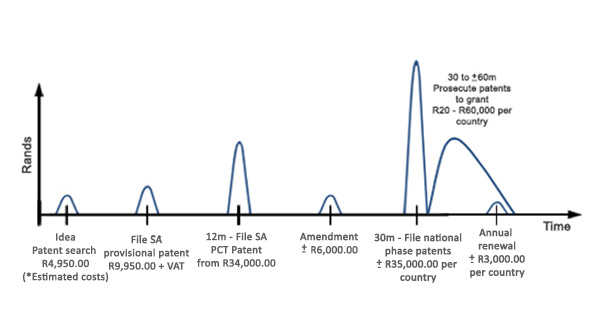How to register a patent in South Africa
To register a patent in South Africa is surprisingly simple, quick and affordable. That’s why S&Z files more than 500 South African patents per month.
South African PCT National Phase Patent Application
South African national phase patent applications may be filed online through GlobalIPCo for only US$399. Alternatively, instruct us to file, prosecute South African national phase patent applications to grant (inclusive of courier of registration certificate) for only US$475.
New Invention – Filing your First Patent Application
But, before contacting a patent attorney, we suggest that you conduct a patent search to identify the features of your invention that have not previously been disclosed anywhere in the world.
After identifying the new, patentable features of your invention, file a South African provisional patent online for only $49 through GlobalIPCo or $99 through Iptica. Use our Patent Template and provisional patent filing guide. This will give you a Patent Pending Number within one business day.
A provisional patent application is effective worldwide.
A day following filing, you will receive a stamped patent application form. Now, go out and start the next phase of the process. Just bear in mind that you have 12 months to file a complete or international patent application.

See our article explaining patents.
12 thoughts on “How to register a patent in South Africa”
Comments are closed.

what happens if I paid the fee and you find out my idea is not patentable. I like your open approach especially prices. i am still going to read patent search with understanding and will come back to you as soon as possible
Hi Samson
If you pay our search fee and we find that your invention is not novel, we will not file a provisional patent. So, you will have paid us only R3850 for the search. We like to take one step at a time. We will only turn to the issue of preparing and filing a provisional patent after we have conducted and reported on the search.
Thanks for your kind words.
Hi guys,
What level of ‘protection’ does the provisional patent application and approval give the inventor, and is this provisional patent honoured by PCT signatories, or must this process be repeated over and over again in each country you want protection in?
The last thing I would like to find is some ‘entrepeneur’ in China watching any provisional patent approvals registered here and copying my idea and registering it in China as his!
Just to keep you busy, sorry, can a patent refer to a concept – I have come up with an idea/concept that solves a particular problem and so far have come up with almost a dozen different designs that could be used to address the concept. Would I need to specify each and every design idea in the concept, or just the concept itself (hope this makes sense!).
Essentially I’m asking how broad a patent’s scope is – can one patent a Rubicks cube with different colours to the original? And yes, I know the Rubicks cube isn’t the best example to use!
Mark
Hi Mark
A provisional patent would need to be followed up by a complete patent (1 year later), which must proceed to grant (which takes approx. 9 months) before that complete patent becomes “enforceable”. However, you will have to wait another 9 months after grant before you can approach a South African court to enforce it. A provisional patent on its own does not give you any enforceable rights against infringers – it only “preserves” your rights to file a complete patent within 12 months.
Most people “respect” provisional patents. For instance. If I know that you have filed a provisional patent that may one day evolve into a complete patent, which may proceed to grant within the country in which I operate, it would influence my activities within the country – I would not wish to set up manufacturing facilities, invest in marketing and advertising only to be interdicted from continuing sale of the product in 9 months’ / 18 months’ time.
Having said this, if you file a provisional patent in SA but do not file a PCT patent or a complete patent within the country in which I operate within 12 months (or, in some instances, 15 months), I will not “respect” or “honour” your provisional patent. The document no longer affords you any rights enforceable against me. For me to respect your patent worldwide, you will need to prosecute a complete patent to grant in each country that I operate.
Also, if you decide not to file a patent in China, no-one else can file a patent for your invention in China – they are not the inventor and the invention is no longer novel (assuming that they learnt of the invention from your disclosure).
I should clarify that provisional patents are maintained secret by the Patent Office – only the title, inventor and applicant names and application number are published. Unless you disclose your invention publicly, your description in your patent application will (generally) not be released to the public until 6 months following filing your corresponding complete patent.
Regarding protecting “concepts”, patents protect “new features” (i.e. “things” you can point to). So, identify the “new feature” that enables your product to work in the new way and patent it. It is best to describe a few of the embodiments, but you are only required to describe the best embodiment known to you. Regarding your Rubicks cube example, new colours would not constitute a “new feature”. Nor, would be it be regarded as inventive. So, a Rubicks cube with a new set of colours would not be patentable.
I have an very simple idea, the description is very simple. do I need a legal firm to fill my applications.
If so. How do I proceed to start the process?
Thank you
Willie
Hi Willie
You can prepare and file a provisional patent application yourself for R60 using our DIY Provisional Patent toolkit.
Alternatively, we would be glad to assist you with your patent application.
The first step is to conduct a patent search to identify the physical features of your invention that are new worldwide (ignoring application of your product).
To do this, you can either use the search software on our website. Else, you can instruct us to conduct a professional worldwide patent search for R3,850.
For us to kick-start the process, all we need is a brief description of your invention (bullet points are fine), and a sketch (if available). We will then contact you to discuss and identify the potentially new features that will form the subject of the search.
After conducting the search, you are ready to turn to drafting a provisional patent (which will reserve your patent rights worldwide for 12 months).
Either before the search or before drafting the provisional patent, we will arrange to meet / discuss your invention and prioritize the new features. We then prepare a draft provisional patent specification and drawings, which we bounce between us until you are satisfied. This typically takes 2 weeks. Once you are happy with the document, we will file the provisional patent at the South African patent office. Our charge to prepare and file a provisional patent is R5,950 exclusive of VAT.
Once the provisional patent has been filed, you are free to disclose your invention publicly.
We also prepare 3D CAD drawings, prototypes, rendered posters – basically, all you need to be able to communicate your idea to potential funders / backers.
Please let me know if I can assist you further.
Anthony
Hi I have an additional feature idea on a existing product.Before approaching the company or investors do I need to register for patent rights ?
Regards
Martin
Hi Martin
I would start by conducting a patent search, just so that you know where you stand. This will be the first question any potential investor will ask. If you are approaching only a few potential investors, you can do so without first patenting your invention, provided that you ask them to sign a confidentiality before disclosing your idea to them. The Confidentiality section on our website has a series of 9 template confidentiality agreement, which you can use for free. But, if you do not necessarily trust the investors, you may as well file a provisional patent first.
Hi there,
What if i found a product in another country and confirmed that it does not have a patent; i cannot source the creator of the product because the product is widley replicated in the other country…
Is there anything i could do to patent it in our country?
Hi Toca
You can only patent features of your invention that are new worldwide. And, if your product is available in another country, your product does not include any new / patentable features. So, you are not able to secure any patent protection in South Africa for the product.
I was busy searching the web for info regarding patent and I came across this page. I cannot believe that someone who is an expert in this field is actually taking their precious time to assist other people that need help….great job guys and thank you.
Here’s my question….hypothetically….say maybe I have an idea or discover a way where I can take one product that is available globally and make it fulfill another function…..for example (and this is a stupid example I know) I discover a way where I can make the normal light bulb make me a cup of coffee by removing or adding some of its hardware or features. Can I patent the process or even the functionality I added or removed from the light bulb?
Hi JJ
Generally, a new application for an existing product is not new. However, should you need to add (not necessarily subtract) a feature to the existing product to make it suitable for that new application, if that added feature is both “new” (irrespective of application) and inventive (i.e. not obvious to an expert in the field), you may patent that added feature. Taking your example: if you modify the lightbulb, those modifications may be patentable. Alternatively, you may need to combine your lightbulb with other components to make coffee. And, that combination may be patentable.
The first prize is to patent the product. However, if your process for making coffee is new (i.e. includes a “new” and “inventive” step, then your new process may also be patentable.